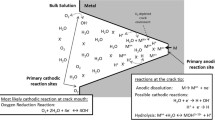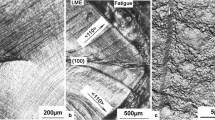Abstract
The concept of oxide-induced crack closure is utilized to explain the role of gaseous and aqueous environments on corrosion fatigue crack propagationat ultralow, near-threshold growth rates in bainitic and martensitic 2 1/4 Cr-1 Mo pressure vessel steels. It is shown that at low load ratios, near-threshold growth rates are significantly reduced in moist environments (such as air or water), compared to dry environments (such as hydrogen or helium gas), due to the formation of excess corrosion deposits on crack faces which enhances crack closure. Using Auger spectroscopy, it is found that at the threshold stress intensity, ΔKo, below which cracks appear dormant, the maximum thickness of excess oxide debris within the crack is comparable with the pulsating crack tip opening displacement. The implications of this model to near-threshold fatigue crack growth behavior, in terms of the role of load ratio, environment, and microstructure are discussed.
Similar content being viewed by others
References
For example, seeProceedings of Intl. Conf. on Corrosion Fatigue,Chemistry, Mechanics, Microstructure, Storrs, Connecticut, Nat. Assoc. Corrosion Engineers, 1971.
R. O. Ritchie, S. Suresh, and C. M. Moss:J. Eng. Mater. Technol., Trans. ASME Series H, 1980, vol. 102, p. 293.
A. T. Stewart:Eng. Fract. Mech., 1980, vol. 13, p, 463.
R. O. Ritchie:Analytical and Experimental Fracture Mechanics, G. C. Sih, and M. Mirabile, eds., Sijthoff and Noordhoff, 1981.
S. Suresh.G. F. Zamiski, and R. O. Ritchie:The Application of 2% Cr-l Mo Pressure Vessel Steel for Thick-Wall Pressure Vessels, ASTM STP 755, 1981.
J. Toplosky: S. M. Thesis, Dept. of Mech. Eng., M.I.T., 1981.
R. J. Cooke and C. J. Beevers:Mater. Sci. Eng., 1974, vol. 13, p. 201.
R. O. Ritchie:Int. Metall. Rev., 1979, vol. 20, p. 205.
D. Benoit, R. Namdar-Tixier, and R. Tixier:Mater. Sci. Eng., 1981, vol. 45, p. 1.
W. Elber: ASTM STP 486, p. 280, 1971.
R. P. Gangloff and R. P. Wei:Metall. Trans. A., 1977, vol. 8A, p. 1043.
G. F. Zamiski: S. M. Thesis, Dept. of Mech. Eng., M.I.T., July 1980.
R. O. Ritchie:Crack Growth Monitoring: Some Considerations on the Electrical Potential Method, Dept. of Metallurgy and Materials Science Technical Report, Cambridge University, Jan. 1972.
R. O. Ritchie:J. Eng. Mater. Technol., Trans. ASME Series H, 1977, vol. 99, p. 195.
S. Suresh, C. M. Moss, and R. O. Ritchie:Trans. Jpn. Inst. Met., 1980, vol. 21, p. 481.
R. O. Ritchie and R. Fuquen-Molano: M.I.T. Fatigue and Plasticity Laboratory Report No. FPL/R/80/1035, Oct. 1980.
R. L. Brazill, G. W. Simmons, and R. P. Wei:J. Eng. Mater. Technol., Trans. ASME, Series H, 1979, vol. 101, p. 199.
J. W. Swanson and H. L. Marcus:Metall. Trans. A., 1978, vol. 9A, p. 291.
L.K.L. Tu and B. B. Seth:J. Test Eval., 1978, vol. 6, p. 66.
G. E. Nordmark and W. G. Fricke:ibid., p. 301.
R. P. Skelton and J. R. Haigh:Mater. Sci. Eng., 1978, vol. 36, p. 17.
P. C. Paris, R. J. Bucci, E. T. Wessel, W. G. Clark, and T. R. Mager: ASTM STP 513, 1972, p. 141.
D. L. Davidson:Fat. Eng. Mat. Struct., 1981, vol. 3, p. 229.
I. C. Mayes, and T. J. Baker:Micromechanisms of Crack Extension, Proc. Conf. on Mechanics and Physics of Fracture II, Metals Society/Institute of Physics, 1981, in press.
N. Walker and C. J. Beevers:Fat. Eng. Mat. Struct., 1979, vol. 1, p. 135.
T. C. Lindley and C. E. Richards: Central Electricity Generating Board Note No. RD/L/N 135/78, Aug. 1978, CERL, U.K.
O. Vosikovsky:Eng. Fract. Mech., 1979, vol. 11, p. 959.
R. O. Ritchie:Met. Sci., 1977, vol. 11, p. 368.
J. Masounave and J.-P. Baïlon:Scr. Metall., 1976, vol. 10, p.165.
C. J. Beevers:Mel. Sci., 1977, vol. 11, p. 362.
G. R. Yoder, L. A. Cooley, and T. W. Crooker:J. Eng. Mater. Technol., Trans. ASME, Series H, 1979, vol. 101, p. 86.
W. W. Gerberich and N. R. Moody: ASTM STP 675, 1979, p. 292.
G. J. Petrak and J. P. Gallagher:J. Eng. Mater. Technol., Trans. ASME, Series H, 1975, vol. 97, p. 206.
Author information
Authors and Affiliations
Additional information
formerly with M.I.T., is with McDonnell-Douglas Corporation, Redondo Beach, CA.
formerly with M.I.T., is Associate Professor, Department of Materials Science and Mineral Engineering, and Lawrence Berkeley Laboratory, University of California, Berkeley, CA 94720.
Rights and permissions
About this article
Cite this article
Suresh, S., Zamiski, G.F. & Ritchie, D.R.O. Oxide-Induced Crack Closure: An Explanation for Near-Threshold Corrosion Fatigue Crack Growth Behavior. Metall Trans A 12, 1435–1443 (1981). https://doi.org/10.1007/BF02643688
Received:
Published:
Issue Date:
DOI: https://doi.org/10.1007/BF02643688



